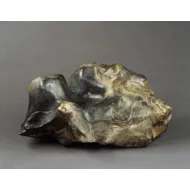A Chinese Black River Boulder, a ‘Moshi’ or Ink Rock
A Chinese Black River Boulder, a ‘Moshi’ or Ink Rock
With a natural water worn smooth surface resembling a mountainous landscape
A Scholars Object
Size: 51 cm long, 33 cm deep, 23 cm high – 20 ins long, 13 ins deep, 9 ins high
With a natural water worn smooth surface resembling a mountainous landscape
A Scholars Object
Size: 51 cm long, 33 cm deep, 23 cm high – 20 ins long, 13 ins deep, 9 ins high
Valued by Chinese Scholars since early times for their shapes, colours and textures, rocks are well documented during the Tang dynasty ( 618-907 A.D ) in poems and paintings. During this period there was a well developed tradition of ‘container’ gardening, and of ‘tray landscapes’ which combined small rocks and plants to form miniature landscapes. Larger rocks were often presented as religious offerings and appear in paintings together with basins filled with stones and coral branches.
By the Song Dynasty information on the display of rocks without plants is given by Du Wan in his ‘Cloud Forrest Stone Records’ dated to 1130; ‘if large they may be set out in garden and hospice; if small they may be placed on a table or stand’. More advice is given for ‘Taihu’ stones which begins with a description of specimens ‘up to 50 feet high’ and continues with stones about a foot in height which ‘are suitable for display by a balcony railing’.
The Ming attitude towards rocks was that they should be enjoyed. The rock should be manipulated and turned to reveal fantastical images and imaginary landscapes contained within the rock should be discovered. By the time of the Qing dynasty scholars were actively engaged in looking for and finding rocks, and placing them, if large, as an adjunct to a garden or distinguished with a stand if small and placed in the scholars studio.
By the Song Dynasty information on the display of rocks without plants is given by Du Wan in his ‘Cloud Forrest Stone Records’ dated to 1130; ‘if large they may be set out in garden and hospice; if small they may be placed on a table or stand’. More advice is given for ‘Taihu’ stones which begins with a description of specimens ‘up to 50 feet high’ and continues with stones about a foot in height which ‘are suitable for display by a balcony railing’.
The Ming attitude towards rocks was that they should be enjoyed. The rock should be manipulated and turned to reveal fantastical images and imaginary landscapes contained within the rock should be discovered. By the time of the Qing dynasty scholars were actively engaged in looking for and finding rocks, and placing them, if large, as an adjunct to a garden or distinguished with a stand if small and placed in the scholars studio.
A Chinese Black River Boulder, a ‘Moshi’ or Ink Rock

SOLD
